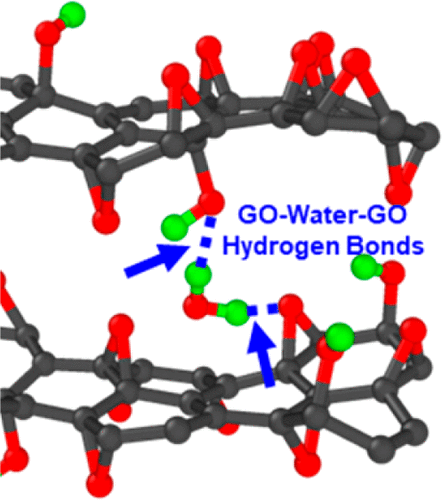Our official English website, www.x-mol.net, welcomes your
feedback! (Note: you will need to create a separate account there.)
The Role of Water in Mediating Interfacial Adhesion and Shear Strength in Graphene Oxide
ACS Nano ( IF 15.8 ) Pub Date : 2018-06-05 00:00:00 , DOI: 10.1021/acsnano.8b02373 Rafael A. Soler-Crespo , Wei Gao 1 , Lily Mao , Hoang T. Nguyen , Michael R. Roenbeck , Jeffrey T. Paci 2 , Jiaxing Huang , SonBinh T. Nguyen , Horacio D. Espinosa
ACS Nano ( IF 15.8 ) Pub Date : 2018-06-05 00:00:00 , DOI: 10.1021/acsnano.8b02373 Rafael A. Soler-Crespo , Wei Gao 1 , Lily Mao , Hoang T. Nguyen , Michael R. Roenbeck , Jeffrey T. Paci 2 , Jiaxing Huang , SonBinh T. Nguyen , Horacio D. Espinosa
Affiliation

|
Graphene oxide (GO), whose highly tunable surface chemistry enables the formation of strong interfacial hydrogen-bond networks, has garnered increasing interest in the design of devices that operate in the presence of water. For instance, previous studies have suggested that controlling GO’s surface chemistry leads to enhancements in interfacial shear strength, allowing engineers to manage deformation pathways and control failure mechanisms. However, these previous reports have not explored the role of ambient humidity and only offer extensive chemical modifications to GO’s surface as the main pathway to control GO’s interfacial properties. Herein, through atomic force microscopy experiments on GO–GO interfaces, the adhesion energy and interfacial shear strength of GO were measured as a function of ambient humidity. Experimental evidence shows that adhesion energy and interfacial shear strength can be improved by a factor of 2–3 when GO is exposed to moderate (∼30% water weight) water content. Furthermore, complementary molecular dynamics simulations uncovered the mechanisms by which these nanomaterial interfaces achieve their properties. They reveal that the strengthening mechanism arises from the formation of strongly interacting hydrogen-bond networks, driven by the chemistry of the GO basal plane and intercalated water molecules between two GO surfaces. In summary, the methodology and findings here reported provide pathways to simultaneously optimize GO’s interfacial and in-plane mechanical properties, by tailoring the chemistry of GO and accounting for water content, in engineering applications such as sensors, filtration membranes, wearable electronics, and structural materials.
中文翻译:

水在介导氧化石墨烯的界面粘附力和剪切强度中的作用
氧化石墨烯(GO)的高度可调节的表面化学性质能够形成牢固的界面氢键网络,因此人们对在水存在下运行的设备的设计越来越感兴趣。例如,以前的研究表明,控制GO的表面化学性质会导致界面剪切强度的提高,从而使工程师能够管理变形路径并控制破坏机理。但是,这些先前的报告并未探讨环境湿度的作用,仅对GO的表面进行了广泛的化学修饰,将其作为控制GO的界面性质的主要途径。在这里,通过在GO-GO界面上的原子力显微镜实验,测量了GO的粘附能和界面剪切强度随环境湿度的变化。实验证据表明,当GO暴露于适度(约30%水重量)的水含量时,粘附能和界面剪切强度可提高2-3倍。此外,互补的分子动力学模拟揭示了这些纳米材料界面实现其性能的机理。他们发现,这种增强机制是由强相互作用的氢键网络的形成引起的,该氢键网络是由GO基础平面的化学作用和两个GO表面之间插入的水分子驱动的。总而言之,此处报道的方法和发现为定制GO的化学成分并考虑水含量提供了同时优化GO的界面和面内机械性能的途径,在工程应用中,例如传感器,滤膜,可穿戴电子产品,
更新日期:2018-06-05
中文翻译:

水在介导氧化石墨烯的界面粘附力和剪切强度中的作用
氧化石墨烯(GO)的高度可调节的表面化学性质能够形成牢固的界面氢键网络,因此人们对在水存在下运行的设备的设计越来越感兴趣。例如,以前的研究表明,控制GO的表面化学性质会导致界面剪切强度的提高,从而使工程师能够管理变形路径并控制破坏机理。但是,这些先前的报告并未探讨环境湿度的作用,仅对GO的表面进行了广泛的化学修饰,将其作为控制GO的界面性质的主要途径。在这里,通过在GO-GO界面上的原子力显微镜实验,测量了GO的粘附能和界面剪切强度随环境湿度的变化。实验证据表明,当GO暴露于适度(约30%水重量)的水含量时,粘附能和界面剪切强度可提高2-3倍。此外,互补的分子动力学模拟揭示了这些纳米材料界面实现其性能的机理。他们发现,这种增强机制是由强相互作用的氢键网络的形成引起的,该氢键网络是由GO基础平面的化学作用和两个GO表面之间插入的水分子驱动的。总而言之,此处报道的方法和发现为定制GO的化学成分并考虑水含量提供了同时优化GO的界面和面内机械性能的途径,在工程应用中,例如传感器,滤膜,可穿戴电子产品,











































 京公网安备 11010802027423号
京公网安备 11010802027423号